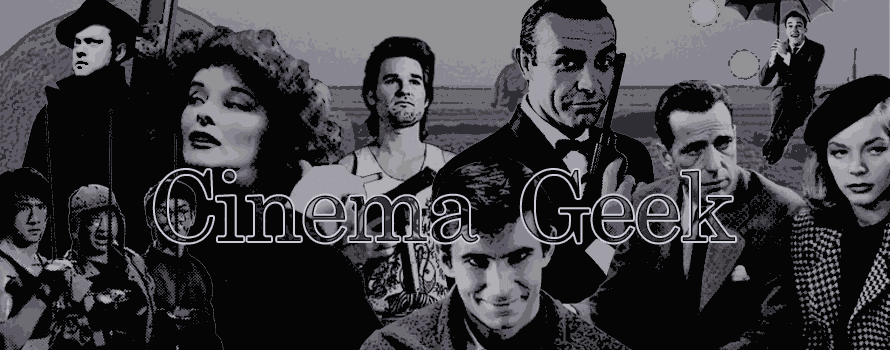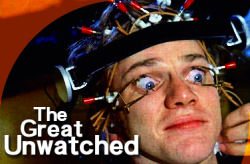 It's fitting that the first color film profiled in this series would be Sergio Leone's 1967 masterpiece Il Buono, Il Brutto, Il Cattivo, a grim yet sumptuous epic that practically redefined the motion picture spectacle for the modern era. The epitome of the beloved sub-genre known as the spaghetti western, it is a film that has so much to offer, and you don't even have to like westerns in general to enjoy it. It is a deeply satisfying film, which succeeds on so many levels and captures the imagination like few others.
It's fitting that the first color film profiled in this series would be Sergio Leone's 1967 masterpiece Il Buono, Il Brutto, Il Cattivo, a grim yet sumptuous epic that practically redefined the motion picture spectacle for the modern era. The epitome of the beloved sub-genre known as the spaghetti western, it is a film that has so much to offer, and you don't even have to like westerns in general to enjoy it. It is a deeply satisfying film, which succeeds on so many levels and captures the imagination like few others.A major crossover hit from the Italian cinema, it works because it speaks the language of action. Sure, the movie has some great lines, but the dialogue is sparse. This is a dynamically visual film, packed with unforgettable imagery, taking full advantage of the iconic Spanish countryside in which it was filmed, as well as some of the most interesting faces ever to be shown on a movie screen. Leone paints what is the very definition of a cinematic portrait, saying so much with expertly designed shots, careful and cautious editing, and some very bold artistic choices.
 Together with Leone, cinematographer Tonino Delli Colli is truly one of the stars here, portraying each and every scene with a sense of heightened reality--vast, sweeping wide shots are intercut with the closest of extreme closeups. It's a technique that has been much parodied since, but it works so well here. That juxtaposition between the tremendously overwhelming, and the intimately introspective can be an intoxicating mix at times, as is the almost rhythmic alternation between shots that linger for alarming amounts of time, and those--such as during the climactic shootout--that whiz by at a dizzying pace. This film makes viewing it an active participation like few others do.
Together with Leone, cinematographer Tonino Delli Colli is truly one of the stars here, portraying each and every scene with a sense of heightened reality--vast, sweeping wide shots are intercut with the closest of extreme closeups. It's a technique that has been much parodied since, but it works so well here. That juxtaposition between the tremendously overwhelming, and the intimately introspective can be an intoxicating mix at times, as is the almost rhythmic alternation between shots that linger for alarming amounts of time, and those--such as during the climactic shootout--that whiz by at a dizzying pace. This film makes viewing it an active participation like few others do. Together with Delli Colli, the film's other star is the legendary Ennio Morricone. Perhaps the most lyrical of all film composers, the scores he wrote for Leone in particular were things of absolute beauty. His daring work on The Good, the Bad and the Ugly represents one of the most recognizable series of musical motifs ever recording for film, and they have been so influential that nowadays it's easy to forget how jarring and unusual his combination of electric guitars, animals sounds, woodwinds and other instruments was, coming after decades of very traditional, much more "conventional" sounding cowboy-and-Indian music. Like few other composers, Morricone's music works so organically with Leone's films, and this film is the greatest example of that.
Together with Delli Colli, the film's other star is the legendary Ennio Morricone. Perhaps the most lyrical of all film composers, the scores he wrote for Leone in particular were things of absolute beauty. His daring work on The Good, the Bad and the Ugly represents one of the most recognizable series of musical motifs ever recording for film, and they have been so influential that nowadays it's easy to forget how jarring and unusual his combination of electric guitars, animals sounds, woodwinds and other instruments was, coming after decades of very traditional, much more "conventional" sounding cowboy-and-Indian music. Like few other composers, Morricone's music works so organically with Leone's films, and this film is the greatest example of that. We have Clint Eastwood in the milieu that made him a star. Although no one would ever classify him as one of the great actors, he is a movie star in the truest sense, dominating the screen with a level of energy that belies his scant amount of lines. His very presence is a statement in and of itself, every time he enters the frame, no matter what he is doing. As the deliciously sinister heavy Angel Eyes, Lee Van Cleef, the New Jersey native with a face made to portray pure evil, is a film villain for the ages. His introduction scene alone is worth the price of admission.
We have Clint Eastwood in the milieu that made him a star. Although no one would ever classify him as one of the great actors, he is a movie star in the truest sense, dominating the screen with a level of energy that belies his scant amount of lines. His very presence is a statement in and of itself, every time he enters the frame, no matter what he is doing. As the deliciously sinister heavy Angel Eyes, Lee Van Cleef, the New Jersey native with a face made to portray pure evil, is a film villain for the ages. His introduction scene alone is worth the price of admission. But truly, although he often does not get credit for it, from a dramatic perspective, this film belongs to Eli Wallach. At that point mainly a stage actor, a previous role in The Magnificent Seven was something of a dress rehearsal for the career-defining role of Tuco, the guy who puts the "ugly" in The Good, the Bad and the Ugly. Conniving, deeply flawed, yet somehow undeniably charismatic, Tuco is one of the most unforgettable movie characters of them all, and Wallach brings a level of depth and humanity to him that I'm sure goes beyond what was on the mere printed page.
But truly, although he often does not get credit for it, from a dramatic perspective, this film belongs to Eli Wallach. At that point mainly a stage actor, a previous role in The Magnificent Seven was something of a dress rehearsal for the career-defining role of Tuco, the guy who puts the "ugly" in The Good, the Bad and the Ugly. Conniving, deeply flawed, yet somehow undeniably charismatic, Tuco is one of the most unforgettable movie characters of them all, and Wallach brings a level of depth and humanity to him that I'm sure goes beyond what was on the mere printed page.Westerns by this point had already become a tired genre, with a more jaded public now weary of the paper-thin representations of good and bad, and the sanitized version of America's past in which they existed. Leone's genius was in being able to take his love of the great westerns of John Ford and others, and push it through the meat grinder of his own decidedly non-American background and sensibilities. Perhaps it was this outsider's perspective that makes the spaghetti western so fascinating. It has been remarked that the most striking thing about them is the way the Italians represent such intrinsically American material.
 The result is something at the same time familiar and exotic. This is, to be sure, not a realistic portrayal of the Old West, no more than the posturing of Gary Cooper and John Wayne is. But it is a slick, stylized and endlessly stimulating synthesis of it; a heady mix of symbolism, sound, color and music that results in something that can only be called "hyper-real"--the Old West as seen through a pulp fiction lens. It is also a world of muddied morality, where the good and the bad are not all that different, and where ugliness abounds. It is a world of mortality, of violence, and of unbridled human emotion.
The result is something at the same time familiar and exotic. This is, to be sure, not a realistic portrayal of the Old West, no more than the posturing of Gary Cooper and John Wayne is. But it is a slick, stylized and endlessly stimulating synthesis of it; a heady mix of symbolism, sound, color and music that results in something that can only be called "hyper-real"--the Old West as seen through a pulp fiction lens. It is also a world of muddied morality, where the good and the bad are not all that different, and where ugliness abounds. It is a world of mortality, of violence, and of unbridled human emotion.The plot is almost irrelevant. Buried Civil War gold, hunted down by greedy and unscrupulous men, who cross paths along the way, and whose adventures take them through deserts, battlefields, graveyards and everywhere in between. But it's not about who did what to whom; the gold, and the search for it, is merely a device to put these incredibly drawn characters into motion, to light the powder keg of explosive action to which we are treated for the course of the film's nearly three-hour running time.
 And yet this is not some mindless action flick, nor is it action in the same style that Sam Peckinpah was creating around the same time. This film is the very definition of a slow-burn, and it is not for the attention-span challenged. But for those with the patience and discipline to expose themselves to the work of a very deliberate and detail-oriented cinematic visionary, The Good, the Bad the Ugly is the kind of film that can grab hold of you and demand repeated viewings.
And yet this is not some mindless action flick, nor is it action in the same style that Sam Peckinpah was creating around the same time. This film is the very definition of a slow-burn, and it is not for the attention-span challenged. But for those with the patience and discipline to expose themselves to the work of a very deliberate and detail-oriented cinematic visionary, The Good, the Bad the Ugly is the kind of film that can grab hold of you and demand repeated viewings.The Good, the Bad and the Ugly, and other standout films of its kind, are of a type of artistic work that could have only occurred at the time they did. Not too far removed from the traditional Westerns of old, yet filtered through a thoroughly modern sensibility, seasoned and packaged in a foreign land and shipped to America, almost as if their makers were looking for approval from the land in which these legends originated, the spaghetti western is a sub-genre which was once marginalized and looked down upon, and is thankfully now rightfully recognized as important, engaging and beautiful. The Good, the Bad and the Ugly represents just about the very best they could be--and yet how ironic, that just a couple of years later, Leone was able to return another time to the Old West for a film that may very well have trumped it...
NEXT UP: 2001: A Space Odyssey (1967)



